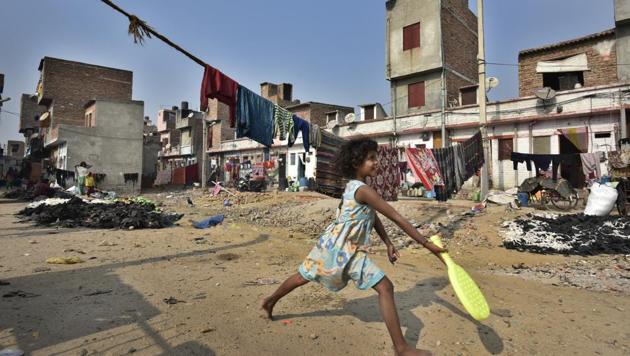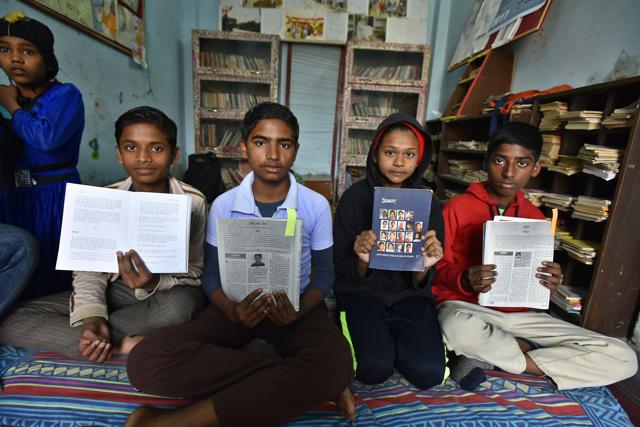Delhi slum turns lab for urban planners, architects, filmmakers testing projects
Savda Ghevra, a resettlement colony on the north-western periphery of Delhi, has been a laboratory for documentary filmmakers, urban planners, researchers, architects both from India and abroad and a host of development organisations, corporate social responsibility (CSR) wings of business houses, all testing their pilot projects.
A group of children huddle in a small room, each holding a book. The room has bookshelves stuffed with Hindi novels. Called Kitab Ghar, the place turns into a literary saloon every day with children discussing art, literature-- and learn to write. And they write well — almost all children here have written short stories that have been published in prestigious Hindi literary magazines such as Hans.

One of them, Gulshan Kumar, 14, is reading his story titled Lallu Sangrina — the tale of a man who comes to Savda Ghevra to get married. Dressed as a groom, he wanders alone on a horse looking for his bride, whose address he does not know.
“What happens to him is a commentary on the place and the people of Savda Ghevra,” says Gulshan, writer at Kitab Ghar, which is part of an alternative learning programme, run by a non-governmental organisation (NGO). “All my stories are set here; Savda Ghevra is my muse,” says Kumar. His friend and fellow writer, Gaurav Kumar, says, Savda Ghevra is full of stories.
It indeed is.
Savda Ghevra, a resettlement colony on the north-western periphery of Delhi, has been a laboratory for documentary filmmakers, urban planners, researchers, architects both from India and abroad and a host of development organisations, corporate social responsibility (CSR) wings of business houses, all testing their pilot projects.

So why is everyone flocking to Savda Ghevra with developmental projects? “It’s Delhi’s newest resettlement colony, is better organised, has better roads compared to other resettlement colonies and most importantly, people are cooperative and there is social harmony here, which is very important for organisations and individuals to carry out their work,” says Justin Jebakumar, director (Delhi), Habitat for Humanity, an international NGO, which helped build several houses in the colony.
Everywhere in Savda Ghevra, there are signs of the government’s flawed, callous idea of resettlement, and experimental engagement of a wide variety of individuals and organisations — there are water ATMs, a pilot project of the Delhi Jal Board where people get water using smart cards, septic tanks designed by a Lon-don-based architect, community development and alternative learning centres run by a host of NGOs, a community archive , where people preserve memories in the form of everyday objects, a facility called Savda Talkies, where inspiring, community- oriented movies are shown on a projector screen.
The streets of the resettlement colony have rows and rows of box-like houses; there is no sewerage system or a water pipeline. Many have called the resettlement colony, spread over 250 acres with over 8,600 plots , a ‘planned slum’. While there is no official estimate on the population living in the colony, a rough estimate pegs it at about 47,000.
The residents of the colony, many of whom were resettled here from places such as Laxmi Nagar, Lodhi Colony, Pragati Maidan say that the government picked and dumped them here without making provisions for basic amenities.
“We were given these tiny plots of 12 meters but no money to build a house,” says Sagira, a resident of O Block, standing outside her house. “Many of the newly constructed houses were whitewashed by a group of Americans a few years back,” she says.
Her neighbours, Anju and Asha, tell how many members of their family moved back to places they were evicted from to earn a living. “My husband spends ₹3,000 a month to travel to work,” says Anju standing outside her house in a narrow street that has rows of cramped houses. Each house, plot accommodates families of four to eight members live within a space of 136 sq ft. “It is neither a city, nor a village, we are actually in the middle of nowhere,” says Anju.
The residents depend on water tankers. In summers, they say, fierce fights break out over water. “At times we do not take bath for days,” says Asha.
She rushes out of her house with two buckets of water, her eight-year-old daughter runs behind. It is 1 pm, time for the water tanker to arrive.
Savda Ghera is also a place of vaulting aspirations and dreams — it is easy to spot youngsters trying to tell you their future plans in English. Its narrow, winding streets have several tawdry establishments offering tuitions and crash course in spoken English.
Jasmine, 17, who studies in a boarding school in Delhi, and is here to spend her winter vacations, says she wants to be a lawyer. “I want to protect the rights of slum children. The middle class and the rich can never imagine what it is like to grow up in a place like this. You start life with many debilitating disadvantages that are difficult to overcome,” says Jasmine, whose mother lives and works in Okhla. “There is no employment here. I do not understand why the government chose this place for us.”
Savda Ghera has no dearth of people — both men and women — aspiring to be the leaders of the community. Yamuna Bhati, for example, has been doing the rounds of colony, visiting NGO offices and ‘influential residents of the colony’. “I am trying to get them to work together to solve the problems of Savda Ghevra,” says Bhati, as she seeks the day’s third appointment with a local leader on her gleaming Android phone. “There is no law and order here, no hospital. There was a murder only yesterday, and nobody is bothered about who killed whom,” she says.
But Bhati says her biggest priority right now is to get a crematorium. “People have to be cremated in open fields and dogs take away the mortal remains in the night,” she says. “The government should at least ensure that the dead here are cremated with dignity,” she adds, pointing at the cremation ground with half a dozen women in tow.
Shahid, a local youth, too has been mobilising youth for community development. He heads Savda Sanghatan, an informal group of youngsters, who recently cleaned parks, and named them after various national leaders.
“These parks were full of garbage, and children had nowhere to play. The government is least bothered about Savda and NGOs can only do so much. Their efforts have paid to the extent that they have kept children and youth engaged in meaningful and constructive activities. Some of them are finding jobs as salesmen in malls, and a lot girls are working in beauty parlours. But what keeps us afloat is the fact that we are a close-knit community comprising people from all castes and religions,” says Shahid.
“Nowhere in Delhi will you find a place where Hindus, Muslims and Christians live peacefully in such close proximity. This is an aware and enlightened community,” he says, , pointing to a group of men engrossed in newspapers on a reading stand placed at a public thoroughfare.
“It is not for nothing that our place has attracted famous architects and filmmakers,” Shahid says.
The architect Shahid is referring to is London-based Julia King, who created a community septic here — and the film in question is a well- acclaimed documentary Noon Day Dispensary by Priya Sen. Set in Savda Ghevra, it raises important questions on eviction, urban planning and resettlement.
“I have worked in many slums and resettlement colonies, but I like Savda the most. I love its environment, its community spirit. People here are really determined to change the course of their destiny,” says Jannu Nagar, who works for Ankur, an NGO.
He is in charge of the local archive housed in a small room close to Kitabh Ghar, which has many documents relating to the colony and everyday objects such as chair, utensils, TV on display. “It is a museum of our memories. It keeps reminding us where we came from and where we are headed,” says Rahul, a student at the local senior secondary school.
Stay updated with all top Cities including, Bengaluru, Delhi, Mumbai and more across India. Stay informed on the latest happenings in World News along with Delhi Election 2025 and Delhi Election Result 2025 Live, New Delhi Election Result Live, Kalkaji Election Result Live at Hindustan Times.
Stay updated with all top Cities including, Bengaluru, Delhi, Mumbai and more across India. Stay informed on the latest happenings in World News along with Delhi Election 2025 and Delhi Election Result 2025 Live, New Delhi Election Result Live, Kalkaji Election Result Live at Hindustan Times.





